Hydrological Design of Two Low-Impact Development Techniques in a Semi-Arid Climate Zone of Central Mexico
Abstract
:1. Introduction
2. Materials and Methods
2.1. Zone Location and Climate
2.2. Description of General Characteristics of the Studied Area
2.3. Bioretention Cell Characteristics
2.4. Estimation of Hydrologic Variables (Tc, i, Qmax, Qa)
- Tc = Concentration time (h).
- L = Maximum length of the runoff path (m).
- S = Slope (no units).
- Rc = Runoff coefficient (no units), 0.8 for asphalt.
- i = Rainfall intensity (m/s).
- A = Drainage surface of the sub-zone S1 (m2).
2.5. Potential Evapotranspiration (PEm) and Consumptive Use of the Vegetal Cover (U)
- PEm = Potential evapotranspiration (mm/month).
- m = Month (i.e., 1, 2, 3...12).
- Nm = Monthly adjustment factor related to hours of daylight (no units).
- Tm = Monthly mean temperature (°C).
- a = Constant (Equation (6)).
- I = Heat efficiency index for m = 1…12 (Equation (7)).
- U = Consumptive use of water by the plant (mm/month).
- Kj = Garden coefficient (no units, Equation (9)).
- F = Growing season consumptive use factor per month (Equation (10)).
- Ke = Constant depending on the species planted (for grasses as Festuca ovina glauca it is 0.4; for succulents is 0.2. The value used for calculations was 0.4).
- Kd = Constant depending on the plant density (0.6 for a mixed planting of low-to-mean density).
- Km = Constant depending on the mean microclimatic conditions (if the buildings contiguous to the planting do not influence the planting microclimate, the value is 1).
- fi = Monthly consumptive factor (mm, Equation (11)).
- T = Monthly mean temperature (°C).
- p = Monthly daylight percentage with respect to the annual value.
2.6. Outlet Runoff of the Bioretention Cell (Qout)
- R = Rainfall.
- Qa = Inlet runoff.
- Ev = Evaporation.
- PEm = Potential evapotranspiration.
- U = Consumptive use.
- Inf = Infiltration.
2.7. Design of the Infiltration Trench
- Qmax = Maximum runoff flow (m3/s).
- At = Cross-sectional area (m2).
- v = Maximum permissible velocity in channels without vegetation (0.45 m/s for easily erodible soils).
- b = width of the trench (m).
- d = water flow depth (m).
- Wp = wetted perimeter (m).
- r = hydraulic radius (m).
- A = 0.114 m2
- b = 0.33 m
- d = 0.35 m
- Wp = 1.026 m
- r = 0.072 m
2.8. Statistical Analysis
3. Results and Discussion
3.1. Temporary Progression of the Plant-Related Variables (PEm and U)
3.2. Bioretention Cell Efficiency
3.3. Infiltration Trench Efficiency
3.4. Analysis of Hydrological Variables (1982, 2010)
3.5. Outlet Runoff Behavior
4. Conclusions
Acknowledgments
Author Contributions
Conflicts of Interest
References
- Mentens, J.; Raes, D.; Hermy, M. Green roofs as a tool for solving the rainwater runoff problem in the urbanized 21st century? Landsc. Urban Plan. 2006, 77, 217–226. [Google Scholar] [CrossRef]
- Arnold, C.L.; Gibbons, C.J. Impervious surface coverage: The emergence of a key environmental indicator. J. Am. Plan. Assoc. 1996, 62, 243–258. [Google Scholar] [CrossRef]
- Qin, H.; Li, Z.; Fu, G. The effects of low-impact development on urban flooding under different rainfall characteristics. J. Environ. Manag. 2013, 129, 577–585. [Google Scholar] [CrossRef] [PubMed] [Green Version]
- Davis, A.P. Field performance of bioretention: Hydrology impacts. J. Hydrol. Eng. 2008, 13, 90–95. [Google Scholar] [CrossRef]
- Locatelli, L.; Mark, O.; Mikkelsen, P.S.; Arnbjerg-Nielsen, K.; Delectic, A.; Roldin, M.; Binning, P.J. Hydrologic impact of urbanization with extensive stormwater infiltration. J. Hydrol. 2017, 544, 524–537. [Google Scholar] [CrossRef]
- Czemiel-Berndtsson, J. Green roof performance towards management of runoff water quantity and quality: A review. Ecol. Eng. 2010, 36, 351–360. [Google Scholar] [CrossRef]
- Mitsch, W.J. Engineering within Ecological Constraints; National Academy Press: Washington, DC, USA, 1996. [Google Scholar]
- Beck, N.G.; Conley, G.; Kanner, L.; Mathias, M. An urban runoff model designed to inform stormwater management decisions. J. Environ. Manag. 2017, 193, 257–269. [Google Scholar] [CrossRef] [PubMed]
- Ahiablame, L.; Shakya, R. Modeling flood reduction effects of low-impact development at a watershed scale. J. Environ. Manag. 2016, 171, 81–91. [Google Scholar] [CrossRef] [PubMed]
- Lenhart, H.A.; Hunt, W.F. Evaluating four storm-water performance metrics with a North Carolina coastal plain storm-water wetland. J. Environ. Eng. 2010, 137, 155–162. [Google Scholar] [CrossRef]
- Roy-Poirier, A.; Champagne, P.; Filion, Y. Review of bioretention system research and design: Past, present, and future. J. Environ. Eng. 2010, 136, 878–889. [Google Scholar] [CrossRef]
- Houdeschel, C.D.; Hultine, K.R.; Johnson, N.C.; Pomeroy, C.A. Evaluation of three vegetation treatments in bioretention gardens in a semi-arid climate. Landsc. Urban Plan. 2015, 135, 62–72. [Google Scholar] [CrossRef]
- Rycewicz-Borecki, M.; McLean, J.E.; Dupont, R.R. Nitrogen and phosphorus mass balance, retention and uptake in six plant species grown in stormwater bioretention microcosms. J. Ecol. Eng. 2017, 99, 409–416. [Google Scholar] [CrossRef]
- Liu, J.; Sample, D.J.; Bell, C.; Guan, Y. Review and research needs of bioretention used for the treatment of urban stormwater. Water 2014, 6, 1069–1099. [Google Scholar] [CrossRef]
- Ortiz-Hernández, J.; Lucho-Constantino, C.; Lizárraga-Mendiola, L.; Beltrán-Hernández, R.I.; Coronel-Olivares, C.; Vázquez-Rodríguez, G. Quality of urban runoff in wet and dry seasons: A case study in a semi-arid zone. Environ. Sci. Pollut. Res. 2016, 23, 25156–25168. [Google Scholar] [CrossRef] [PubMed]
- Houdeshel, C.D.; Pomeroy, C.A.; Hultine, K.R. Bioretention design for xeric climates based on ecological principles. JAWRA J. Am. Water Resour. Assoc. 2012, 48, 1178–1190. [Google Scholar] [CrossRef]
- Meteorological National Service. Pronóstico del Tiempo por Municipios. Available online: http://smn.cna.gob.mx/es/pronostico-del-tiempo-por-municipios (accessed on 8 April 2016). (In Spanish).
- Lizárraga-Mendiola, L.; Vázquez-Rodríguez, G.; Blanco-Piñón, A.; Rangel-Martínez, Y.; González-Sandoval, M. Estimating the rainwater potential per household in an urban area: Case study in Central Mexico. Water 2015, 7, 4622–4637. [Google Scholar] [CrossRef]
- Ortiz-Hernández, J. Biorretención de Agua de Escorrentía Urbana Para su Tratamiento y Reúso. Ph.D. Thesis, Universidad Autónoma del Estado de Hidalgo, Pachuca, Mexico, 2016. (In Spanish). [Google Scholar]
- Bagarello, V.; Sferlazza, S.; Sgroi, A. Comparing two methods of analysis of single-ring infiltrometer data for a sandy–loam soil. Geoderma 2009, 149, 415–420. [Google Scholar] [CrossRef]
- Coffman, L.S.; Goo, R.; Frederick, R. Low-Impact Development: An Innovative Alternative Approach to Stormwater Management. In WRPMD’99: Preparing for the 21st Century, Proceedings of the 29th Annual Water Resources Planning and Management Conference, Tempe, AZ, USA, 6–9 June 1999; pp. 1–10. [Google Scholar]
- Samuel, J.; Coulibaly, P.; Dumedah, G.; Moradkhani, H. Assessing model state and forecasts variation in hydrologic data assimilation. J. Hydrol. 2014, 513, 127–141. [Google Scholar] [CrossRef]
- Food and Agriculture Organization of the United Nations. Guidelines for Predicting Crop Water Requirements; Food and Agriculture Organization of the United Nations: Rome, Italy, 1977. [Google Scholar]
- Martín-Rodríguez, A.; Ávila-Alabarces, R.; Yruela-Morillo, M.C.; Plaza-Zarza, R.; Navas-Quesada, A.; Fernández-Gómez, R. Manual de Riego de Jardines; Junta de Andalucía, Consejería de Agricultura y Pesca: Sevilla, Spain, 2010. [Google Scholar]
- Bascuñán-Fuentes, E.E. Eficiencia Hídrica Aplicada a la Plaza de Armas de Quilicura: Propuesta de Rediseño Mediante Principios de Xerojardinería y Recolección de Aguas Pluviales. Bachelor’s Thesis, Universidad Andrés Bello, Santiago, Chile, 2013. (In Spanish). [Google Scholar]
- United States Department of Agriculture. Threshold Channel Design. In Part 654 Stream Restoration Design National Engineering Handbook; National Resources Conservation Service, United States Department of Agriculture: Washington, DC, USA, 2007. [Google Scholar]
- United States Department of Agriculture. Soil Quality Test Kit Guide; Soil Quality Institute, United States Department of Agriculture: Washington, DC, USA, 1999.
- Lucho-Constantino, C.A.; Álvarez-Suárez, M.; Beltrán-Hernández, R.I.; Prieto-García, F.; Poggi-Varaldo, H.M. A multivariate analysis of the accumulation and fractionation of major and trace elements in agricultural soils in Hidalgo State, Mexico irrigated with raw wastewater. Environ. Int. 2005, 31, 313–323. [Google Scholar] [CrossRef] [PubMed]
- Asleson, B.C.; Nestingen, R.S.; Gulliver, J.S.; Hozalski, R.M.; Nieber, J.L. Performance Assessment of Rain Gardens. JAWRA J. Am. Water Resour. Assoc. 2009, 45, 1019–1031. [Google Scholar] [CrossRef]
- Endreny, T.; Collins, V. Implications of bioretention basin spatial arrangements on stormwater recharge and groundwater mounding. Ecol. Eng. 2009, 35, 670–677. [Google Scholar] [CrossRef]
- Khan, U.T.; Valeo, C.; Chu, A.; He, J. A Data Driven Approach to Bioretention Cell Performance—Prediction and Design. Water 2013, 5, 13–28. [Google Scholar] [CrossRef]
- Liu, Y.; Bralts, V.F.; Engel, B.A. Evaluating the effectiveness of management practices on hydrology and water quality at watershed scale with a rainfall-runoff model. Sci. Total Environ. 2015, 511, 298–309. [Google Scholar] [CrossRef] [PubMed]
- Cotillas, M.; Sabaté, S.; Gracia, C.; Espelta, J.M. Growth response of mixed Mediterranean oak coppices to rainfall reduction. For. Ecol. Manag. 2009, 258, 1677–1683. [Google Scholar] [CrossRef]
- Stewart, B.A.; Liang, W.-L. Strategies for increasing the capture, storage, and utilization of precipitation in semi-arid regions. J. Integr. Agric. 2015, 14, 1500–1510. [Google Scholar] [CrossRef]
- Saraswat, C.; Kumar, P.; Mishra, B.K. Assessment of stormwater runoff management practices and governance under climate change and urbanization. Environ. Sci. Policy 2016, 64, 101–117. [Google Scholar] [CrossRef]
- Feng, Y.; Burian, S.; Pomeroy, C. Potential of green infrastructure to restore predevelopment water budget of a semi-arid urban catchment. J. Hydrol. 2016, 542, 744–755. [Google Scholar] [CrossRef]
- Hathaway, J.M.; Brown, R.A.; Fu, J.S.; Hunt, W.F. Bioretention function under climate change scenarios in North Carolina, USA. J. Hydrol. 2014, 519, 503–511. [Google Scholar] [CrossRef]
- Willems, P.; Arnbjerg-Nielsen, K.; Olsson, J.; Nguyen, V.T.V. Climate change impact assessment on urban rainfall extremes and urban drainage: Methods and shortcomings. Rainfall Urban Context Forecast. Risk Clim. Chang. 2012, 103, 106–118. [Google Scholar] [CrossRef]
- Berggren, K.; Olofsson, M.; Viklander, M.; Svensson, G.; Gustafsson, A.-M. Hydraulic Impacts on Urban Drainage Systems due to Changes in Rainfall Caused by Climatic Change. J. Hydrol. Eng. 2012, 17, 92–98. [Google Scholar] [CrossRef]
- Wang, J.; Zhang, P.; Yang, L.; Huang, T. Cadmium removal from urban stormwater runoff via bioretention technology and effluent risk assessment for discharge to surface water. J. Contam. Hydrol. 2016, 185, 42–50. [Google Scholar] [CrossRef] [PubMed]
- Secretaría de Comunicaciones y Transporte. Isohyets of Intensity, Duration, Period of Return for the Mexican Republic. 2015. Available online: http://www.sct.gob.mx/fileadmin/DireccionesGrales/DGST/Isoyetas/hidalgo.pdf (accessed on 21 May 2017).
- Lucke, T.; Nichols, P.W.B. The pollution removal and stormwater reduction performance of street-side bioretention basins after ten years in operation. Sci. Total Environ. 2015, 536, 784–792. [Google Scholar] [CrossRef] [PubMed]
- Lucas, S.A.; Coombes, P.J.; Hardy, M.J.; Geary, P.M. Rainwater harvesting: Revealing the detail. J. Aust. Water Assoc. 2006, 33, 50–55. [Google Scholar]
- Le Costumer, S.; Fletcher, T.D.; Deletic, A.; Barraud, S.; Lewis, J.F. Hydraulic performance of biofilter systems for stormwater management—Influences of design and operation. J. Hydrol. 2009, 376, 16–23. [Google Scholar] [CrossRef]
- Bell, C.D.; McMillan, S.K.; Clinton, S.M.; Jefferson, A.J. Hydrologic response to stormwater control measures in urban watersheds. J. Hydrol. 2016, 541, 1488–1500. [Google Scholar] [CrossRef]
- Gogate, N.G.; Kalvar, P.P.; Raval, P.M. Assessment of stormwater management options in urban contexts using Multiple Attribute Decision-Making. J. Clean. Prod. 2017, 142, 2046–2059. [Google Scholar] [CrossRef]
- Richards, P.J.; Williams, N.S.G.; Fletcher, T.D.; Farrell, C. Can rain gardens produce food and retain stormwater effects of substrates and stormwater application method on plant water use, stormwater retention and yield. Ecol. Eng. 2017, 100, 165–174. [Google Scholar] [CrossRef]
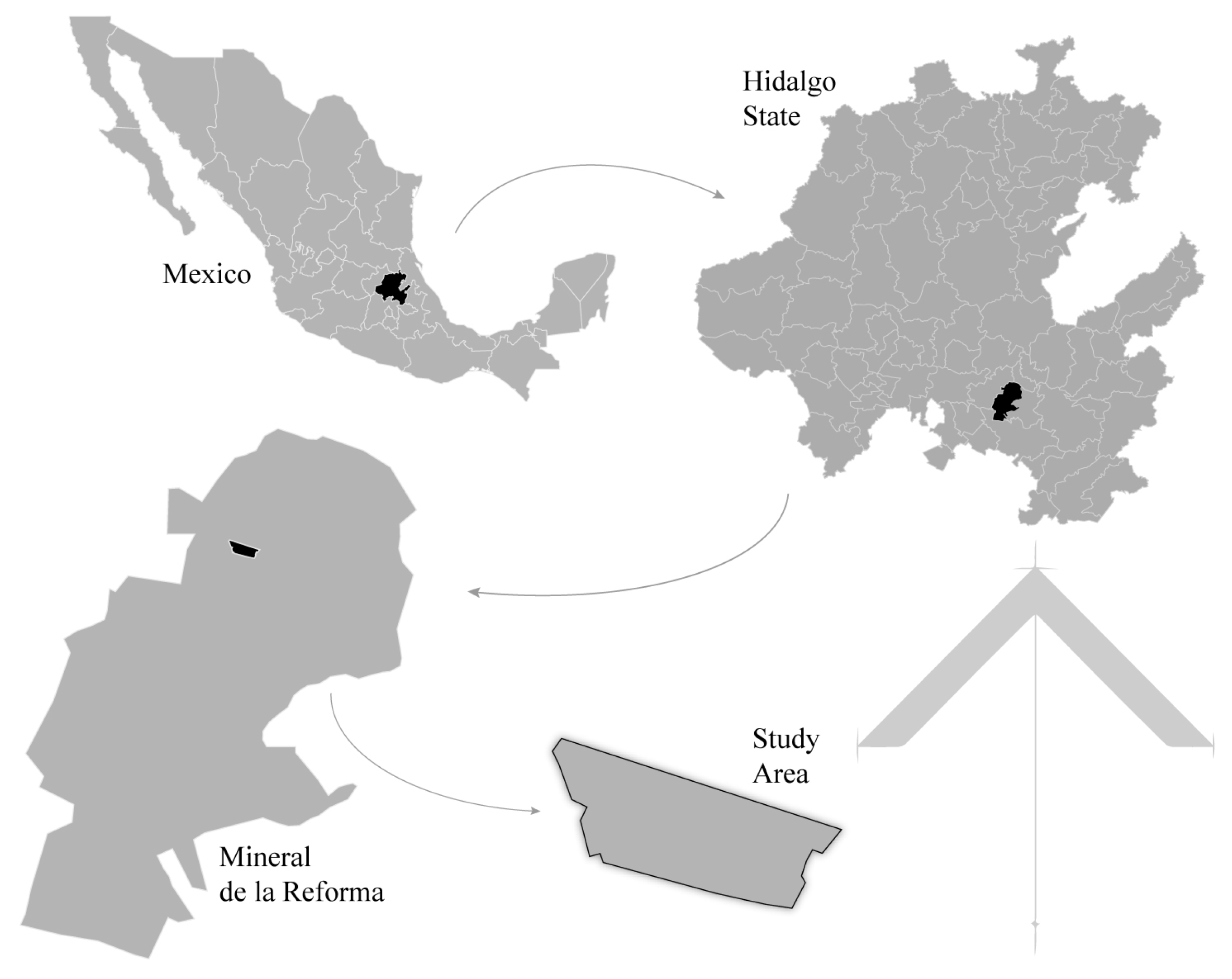
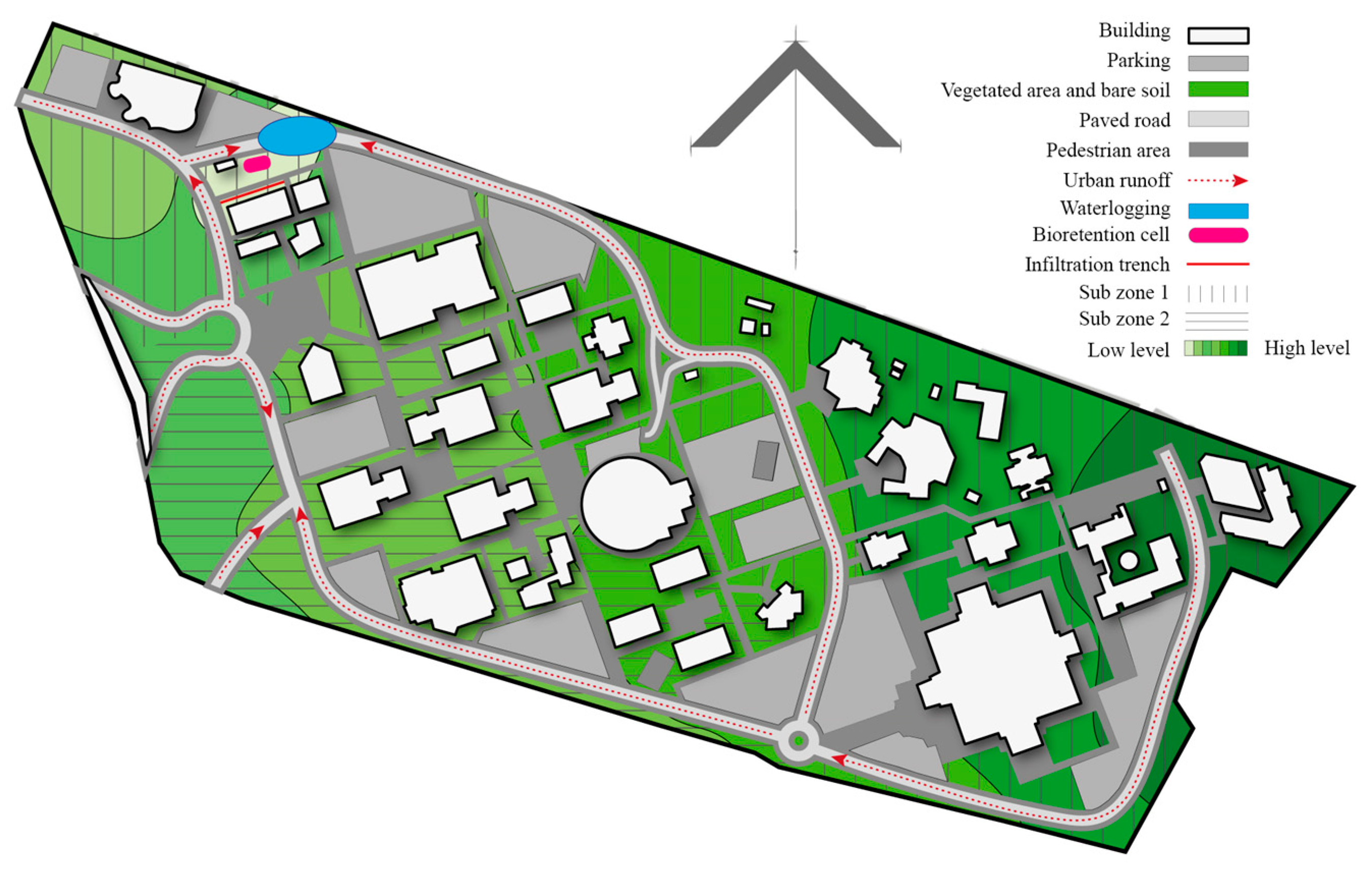
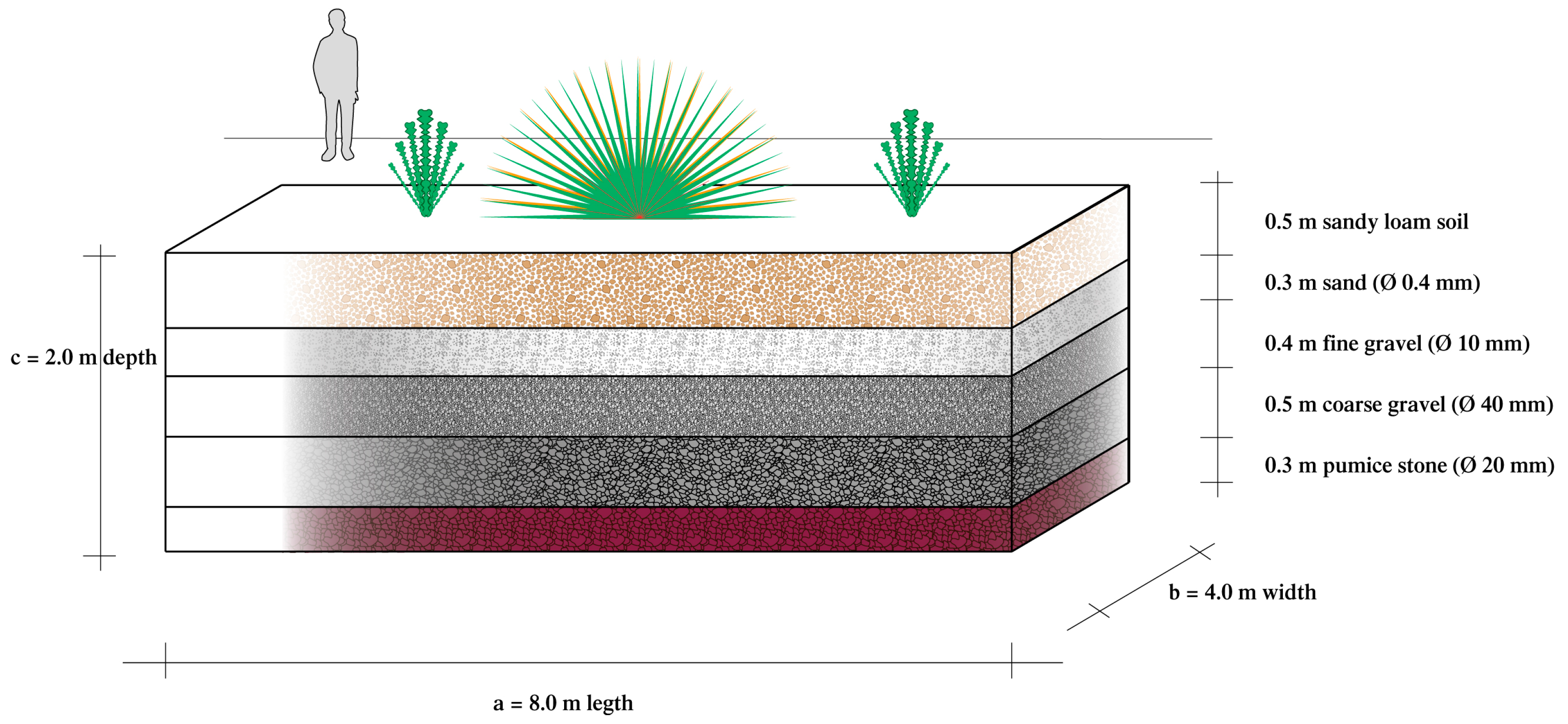

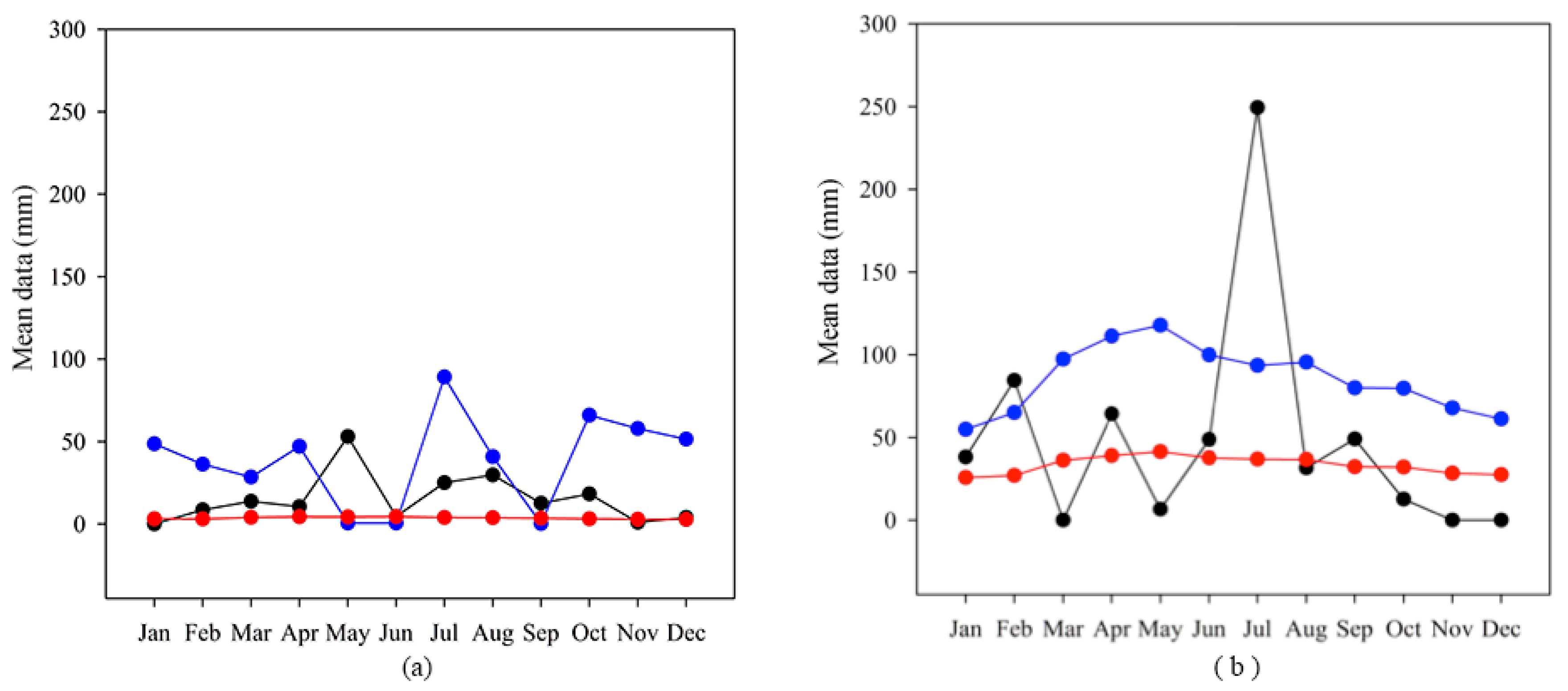
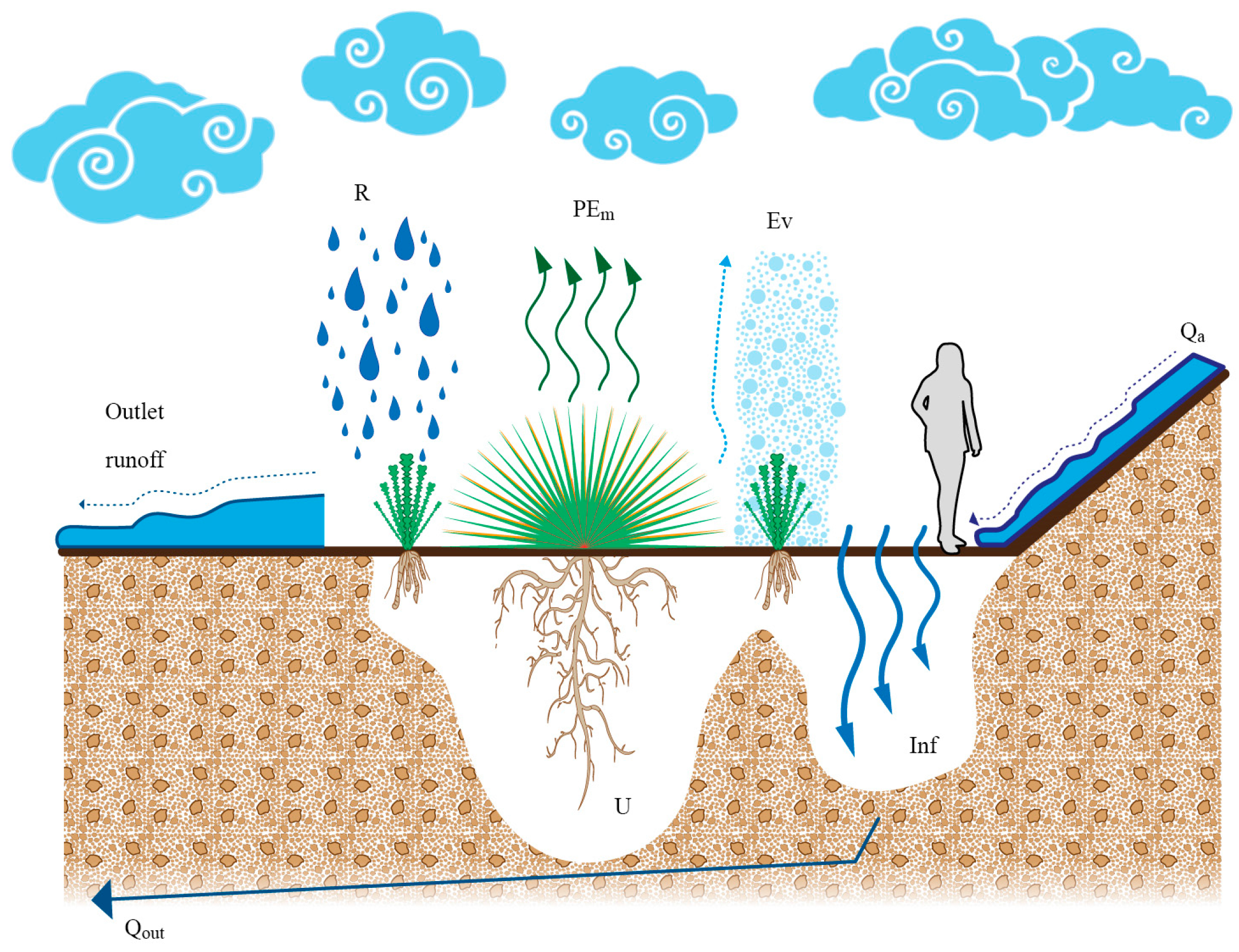
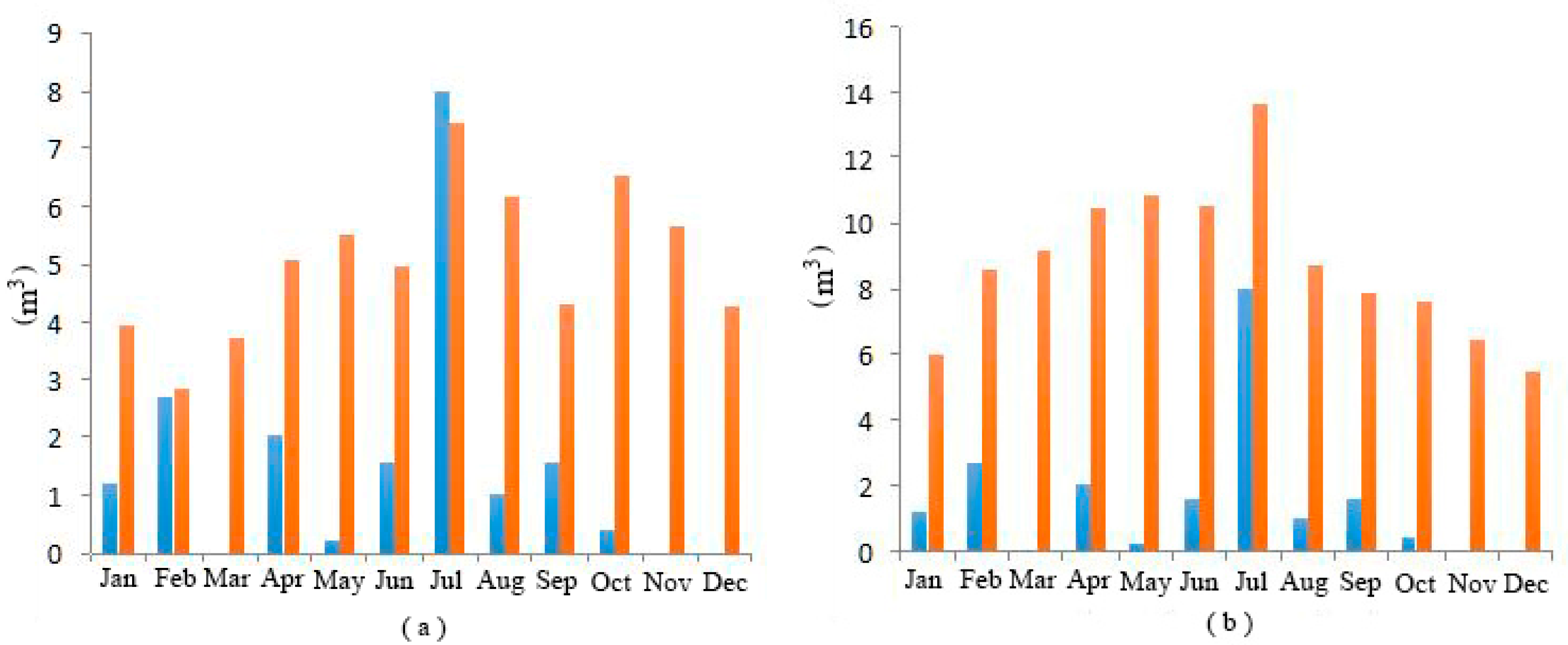

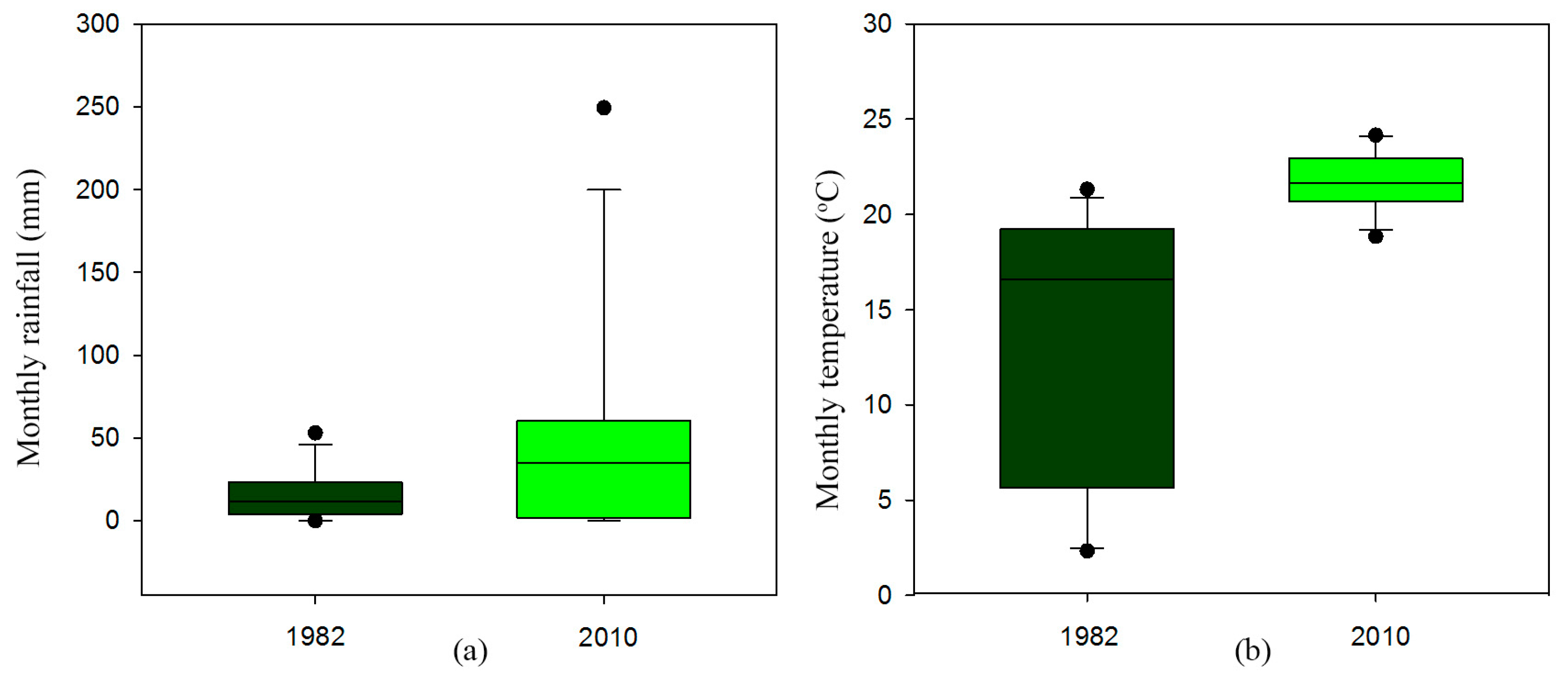
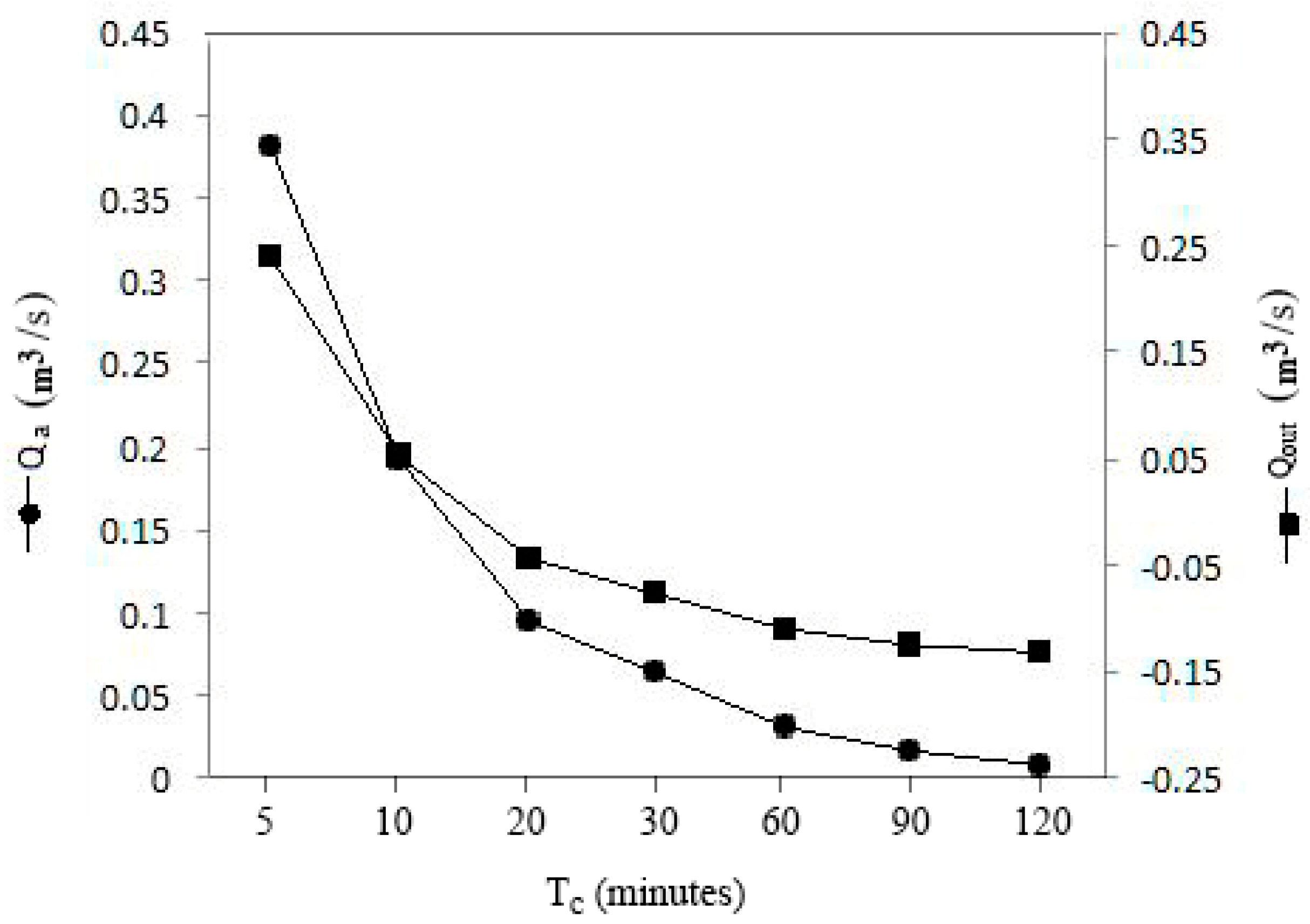
| Total Surface of the University Campus | 298,713.29 m2 | 100% |
|---|---|---|
| Surface of the sub-zone (S1) | 213,580 m2 | 71.5% |
| From this: | - | - |
| Impermeable area (buildings) | 34,172.80 m2 | 16.0% |
| Impermeable area (asphalt) | 68,345.60 m2 | 32.0% |
| Permeable area (vegetated and bare soil) | 111,061.60 m2 | 52.0% |
| Length of the surface runoff (L) | 3039.55 m | - |
| Slope of the surface runoff (S) | 0.051 (no units) | - |
| Runoff coefficient (Rc, asphalt) | 0.8 (no units) | - |
| Variable | 1982 | 2010 | ||||||
|---|---|---|---|---|---|---|---|---|
| Min. | Max. | Mean | Standard Deviation | Min. | Max. | Mean | Standard Deviation | |
| Temperature (T) [°C] | 2.33 | 21.32 | 14.00 * | 7.11 | 18.85 | 24.16 | 21.74 * | 1.57 |
| Rainfall (R) [mm] | 0.00 | 53.00 | 15.09 | 15.05 | 0.00 | 249.40 | 48.80 | 69.00 |
| Evaporation (Ev) [mm] | 25.60 | 143.70 | 85.54 * | 34.29 | 76.75 | 174.93 | 116.41 * | 30.16 |
| Infiltration (Inf) [mm] | 0.00 | 42.40 | 12.07 | 12.04 | 0.00 | 199.52 | 39.04 | 55.20 |
| Consumptive use (U) [mm] | 0.36 | 89.15 | 38.94 * | 27.74 | 54.93 | 117.86 | 85.40 * | 20.31 |
| Potential evapotranspiration (PEm) [mm] | 2.76 | 4.51 | 3.64 * | 0.63 | 25.80 | 41.56 | 33.47 * | 5.28 |
| Variable | Temperature (T) | Rainfall (R) | Infiltration (Inf) | Consumptive Use (U) | Potential Evapotranspiration (PEm) | Evaporation (E) | Output Runoff (Qout) | %Qout |
|---|---|---|---|---|---|---|---|---|
| Temperature (T) | 1.000 | −0.322 | −0.322 | 0.945 ** | −0.505 | −0.651 * | −0.376 | −0.339 |
| Rainfall (R) | - | 1.000 | 1.000 ** | −0.196 | 0.481 | 0.396 | 0.890 ** | 0.942 ** |
| Infiltration (Inf) | - | - | 1.000 | −0.196 | 0.481 | 0.396 | 0.890 ** | 0.942 ** |
| Consumptive use (U) | - | - | - | 1.000 | −0.398 | −0.454 | −0.368 | −0.278 |
| Potential evapotranspiration (PEm) | - | - | - | - | 1.000 | 0.545 | 0.368 | 0.456 |
| Evaporation (Ev) | - | - | - | - | - | 1.000 | 0.086 | 0.218 |
| Output runoff (Qout) | - | - | - | - | - | - | 1.000 | 0.951 ** |
| %Qout | - | - | - | - | - | - | - | 1.000 |
| Variable | Temperature (T) | Rainfall (R) | Infiltration (Inf) | Consumptive Use (U) | Potential Evapotranspiration (PEm) | Evaporation (Ev) | Output Runoff (Qout) | %Qout |
|---|---|---|---|---|---|---|---|---|
| Temperature (T) | 1.000 | 0.004 | 0.004 | 0.969 ** | 0.933 ** | 0.831 ** | −0.108 | 0.626 * |
| Rainfall (R) | - | 1.000 | 1.000 ** | 0.114 | 0.171 | −0.249 | 0.993 ** | 0.070 |
| Infiltration (Inf) | - | - | 1.000 | 0.114 | 0.171 | −0.249 | 0.993 ** | 0.070 |
| Consumptive use (U) | - | - | - | 1.000 | 0.991 ** | 0.808 ** | −0.001 | 0.654 * |
| Potential evapotranspi-ration (PEm) | - | - | - | - | 1.000 | 0.768 ** | 0.059 | 0.645 * |
| Evaporation (Ev) | - | - | - | - | - | 1.000 | −0.359 | −0.601 * |
| Output runoff (Qout) | - | - | - | - | - | - | 1.000 | −0.009 |
| %Qout | - | - | - | - | - | - | - | 1.000 |
© 2017 by the authors. Licensee MDPI, Basel, Switzerland. This article is an open access article distributed under the terms and conditions of the Creative Commons Attribution (CC BY) license (http://creativecommons.org/licenses/by/4.0/).
Share and Cite
Lizárraga-Mendiola, L.; Vázquez-Rodríguez, G.A.; Lucho-Constantino, C.A.; Bigurra-Alzati, C.A.; Beltrán-Hernández, R.I.; Ortiz-Hernández, J.E.; López-León, L.D. Hydrological Design of Two Low-Impact Development Techniques in a Semi-Arid Climate Zone of Central Mexico. Water 2017, 9, 561. https://doi.org/10.3390/w9080561
Lizárraga-Mendiola L, Vázquez-Rodríguez GA, Lucho-Constantino CA, Bigurra-Alzati CA, Beltrán-Hernández RI, Ortiz-Hernández JE, López-León LD. Hydrological Design of Two Low-Impact Development Techniques in a Semi-Arid Climate Zone of Central Mexico. Water. 2017; 9(8):561. https://doi.org/10.3390/w9080561
Chicago/Turabian StyleLizárraga-Mendiola, Liliana, Gabriela A. Vázquez-Rodríguez, Carlos Alexander Lucho-Constantino, Carlos Alfredo Bigurra-Alzati, Rosa Icela Beltrán-Hernández, Joyce Edith Ortiz-Hernández, and Luis D. López-León. 2017. "Hydrological Design of Two Low-Impact Development Techniques in a Semi-Arid Climate Zone of Central Mexico" Water 9, no. 8: 561. https://doi.org/10.3390/w9080561








